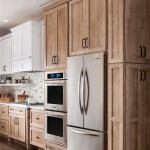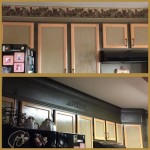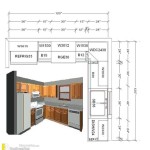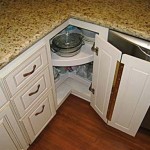How To Organize Kitchen Cabinets: Food Storage Strategies
Organizing kitchen cabinets, particularly those dedicated to food storage, is a fundamental aspect of maintaining an efficient and functional kitchen. A well-organized pantry and food storage system can significantly reduce food waste, streamline meal preparation, and improve the overall accessibility of ingredients. The process involves careful planning, strategic categorization, and consistent maintenance to achieve optimal results.
Effective food storage organization is not merely about aesthetics; it directly impacts food safety and budgetary considerations. Expired or forgotten items are a common source of unnecessary waste. A clear and logical system helps ensure that food is used before its expiration date, minimizing spoilage and maximizing the value of purchases. Furthermore, an organized kitchen simplifies the inventory process, allowing for more accurate grocery lists and preventing duplicate purchases. This, in turn, contributes to a more sustainable and cost-effective household.
Before initiating the organization process, it is crucial to assess the current state of the kitchen cabinets. This involves taking inventory of all existing food items, noting expiration dates, and evaluating the current storage system. This initial assessment provides a baseline for determining the necessary changes and identifying areas for improvement. Consider the frequency with which different items are used; frequently accessed ingredients should be placed in more accessible locations, while less frequently used items can be stored further back or higher up.
The organizational process can be broken down into several key steps. These include decluttering, cleaning, categorizing, and implementing storage solutions. Each step plays a critical role in creating a functional and sustainable food storage system. Prioritizing these steps ensures a methodical approach, preventing overwhelm and maximizing efficiency.
Decluttering and Inventory Management
The first step in organizing food storage cabinets involves a thorough decluttering process. This requires removing all items from the cabinets and carefully inspecting each for expiration dates. Expired items should be discarded immediately. Pay close attention to items that may have been stored for an extended period without being used. If an item is unlikely to be used in the foreseeable future, consider donating it to a local food bank or pantry, provided it is still within its expiration date and in good condition.
Once expired and unwanted items have been removed, the next step is to take a comprehensive inventory of the remaining food items. This can be done manually, by creating a written list, or digitally, using a spreadsheet or a dedicated inventory management application. The inventory should include a description of each item, its quantity, and its expiration date. This inventory will serve as a reference point for future grocery shopping and meal planning.
Consider separating items into different categories during the inventory process. Common categories include canned goods, dry goods (such as pasta, rice, and grains), baking supplies, snacks, and condiments. This categorization will form the basis for organizing the items within the cabinets. Grouping similar items together streamlines the process of locating ingredients and simplifies meal preparation.
It is essential to be realistic about consumption habits during the decluttering process. Avoid retaining items that are unlikely to be used simply because they were purchased at some point. A willingness to part with unwanted items is crucial for creating a truly functional and organized food storage system. This proactive approach minimizes clutter and reduces the risk of future food waste.
After decluttering, assess the types of food you tend to buy. Do you buy in bulk for pantry staples like rice and beans? Or do you buy mostly perishable foods that don't get stored in cabinets? Adapting your storage strategy for your particular needs is necessary for a sustainable organization system.
Cleaning and Preparing the Cabinets
After decluttering, the next crucial step is thoroughly cleaning the interior of the kitchen cabinets. This process removes dust, crumbs, and any other debris that may have accumulated over time. Start by vacuuming the interior of the cabinets to remove loose particles. Then, using a damp cloth or sponge with a mild detergent, wipe down all surfaces, including shelves, walls, and doors. Pay close attention to any areas with spills or stains. Ensure that all surfaces are completely dry before returning food items to the cabinets.
Consider using shelf liners to protect the cabinet surfaces and make cleaning easier in the future. Shelf liners provide a barrier against spills and crumbs, preventing them from penetrating the cabinet material. They also make it easier to wipe up messes, as the liner can be removed and cleaned separately. There are various types of shelf liners available, including non-adhesive, adhesive, and washable options. Choose a type that suits your preferences and the specific needs of your cabinets.
While cleaning, inspect the cabinets for any signs of pests, such as insects or rodents. If any pests are detected, take appropriate measures to eliminate them before proceeding with the organization process. This may involve using insecticide sprays, traps, or professional pest control services. Addressing pest issues promptly is crucial for maintaining food safety and preventing further damage to the cabinets.
Ensure that the cabinets are properly ventilated to prevent the buildup of moisture, which can lead to mold and mildew growth. Avoid overcrowding the cabinets, as this can restrict airflow. Consider using dehumidifiers or moisture-absorbing products in areas prone to high humidity. Regular ventilation helps maintain a dry and hygienic environment for food storage.
Before replacing any items, it might be useful to consider the arrangement of existing shelves. Are they adjustable? If so, can you position them to better accommodate your food storage needs? Often, a simple adjustment of shelf height can create more usable space.
Implementing Storage Solutions and Categorization Strategies
With the cabinets decluttered and cleaned, the next step is to implement storage solutions and develop a categorization strategy. This involves selecting appropriate storage containers, arranging food items in a logical manner, and labeling everything clearly. The goal is to create a system that is both efficient and easy to maintain.
Choose storage containers that are appropriate for the types of food being stored. Clear, airtight containers are ideal for storing dry goods such as pasta, rice, and grains. These containers protect food from moisture, pests, and oxidation, extending their shelf life. They also allow for easy visibility of contents, making it simple to identify ingredients at a glance. Consider using stackable containers to maximize vertical space within the cabinets.
Utilize organizational tools such as lazy Susans, tiered shelves, and drawer dividers to maximize space and improve accessibility. Lazy Susans are particularly useful for storing condiments, spices, and other small items that can easily get lost in the back of the cabinet. Tiered shelves allow for better visibility of items stored on higher shelves. Drawer dividers help keep utensils and other kitchen tools organized within drawers.
Label all storage containers clearly with the name of the food item and its expiration date. This ensures that food is used before it expires and prevents confusion when locating ingredients. Use a permanent marker or a label maker to create clear and legible labels. If desired, include the date the item was stored on the label as well. Consistent labeling is crucial for maintaining an organized food storage system.
Arrange food items within the cabinets based on their category and frequency of use. Frequently used items should be placed in easily accessible locations, while less frequently used items can be stored further back or higher up. Group similar items together to streamline meal preparation. For example, store all baking supplies in one area and all canned goods in another. This logical arrangement makes it quick and easy to find the ingredients needed for any recipe.
Consider the age of food items when placing them in storage. Employ the FIFO (First In, First Out) method: place newer items behind older items of the same type. This ensures that the older items are used first, minimizing the risk of spoilage and waste. Regularly rotate food items to maintain optimal freshness and prevent items from expiring unnoticed.
A good storage system also considers placement in relation to appliances. Spices for the stove might best be kept near the stove, while items for baking may be best stored near the oven. Keeping items where they will be most used helps improve efficiency.
Adopting these organizational strategies will significantly improve the functionality of kitchen cabinets and food storage areas. This reduces food waste, streamlines meal preparation, and simplifies the overall cooking experience. By implementing these guidelines, kitchens can be transformed into more efficient and user-friendly environments.

How To Organize A Pantry Best Organizers And Tips 2024

How To Organize Kitchen Cabinets

Pin On Kitchen

Organizing Our New Kitchen S Cabinets Young House Love

20 Genius Kitchen Cabinet Organization Ideas A Cultivated Nest

Simplify Your Life With Organized Kitchen Cabinets
21 Ways To Organize Kitchen Cabinets Declutter

The Complete Guide To Kitchen Organization And Storage Super Healthy Kids

How To Organize Your Kitchen Cabinets In 3 Simple Steps Practical Perfection

How To Organize The Food In Your Kitchen Cabinets And Pantry








